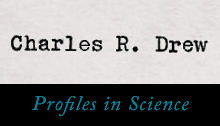Education
Higher Education Modules
Life after Death: Dr. Charles Drew, Civil Rights, and the Legacy of Race
Class 2: Father of the Blood Bank
Introduction
Since at least the 1920s scientists and physicians searched for methods that would allow for the preservation and transportation of blood products. Separating blood plasma (liquid portion containing proteins and electrolytes) from whole blood was a major innovation, providing a potentially life-saving blood substitute that was much less perishable and much more portable than whole blood. Although Dr. Charles Drew was not alone in working on blood plasma preservation and storage, his work became vitally important in standardizing and universalizing methods for this process throughout the world. Drew’s work revolutionized surgery through the development and operation of blood banks, the first of which he helped create during World War II called the Blood for Britain Program that ultimately led to what we now know as the American Red Cross Blood Bank.
Readings
Primary Sources
Drew, Charles R. Memorandum from Charles R. Drew to John Bush on the establishment of a permanent “blood bank” on January 31, 1940. Moorland-Spingarn Research Center, Howard University. From National Library of Medicine: Profiles in Science: The Charles R. Drew Papers. //profiles.nlm.nih.gov/ps/retrieve/ResourceMetadata/BGBBBZ.
"[Charles R. Drew with the first mobile collecting unit, February 1941.]" Photograph. Moorland-Spingarn Research Center, Howard University. From National Library of Medicine: Profiles in Science: The Charles R. Drew Papers. //profiles.nlm.nih.gov/ps/retrieve/ResourceMetadata/BGBBFL.
Scurlock, Addison, photographer. “[Portrait of Charles Drew sitting at his desk, ca. 1947.]” Photograph. Washington, DC: Scurlock Studio Records, Archives Center, National Museum of American History, Behring Center, Smithsonian Institution. From National Library of Medicine: Profiles in Science: The Charles R. Drew Papers. //profiles.nlm.nih.gov/ps/retrieve/ResourceMetadata/BGBBCV.
Supplementary Reading
Drew, Charles R. "Banked Blood: A Study in Blood Preservation." PhD diss., Columbia University and Presbyterian Hospital, 1940, pp. 205–215. //profiles.nlm.nih.gov/ps/retrieve/ResourceMetadata/BGBBJT.
Secondary readings
Howell, Joel D. Technology in the Hospital: Transforming Patient Care in the Early Twentieth Century. Baltimore: Johns Hopkins University Press, 1995, chapters 6 and 7.
Wailoo, Keith. Drawing Blood: Technology and Disease Identity in Twentieth-Century America. Baltimore: Johns Hopkins University Press, 1997, pp. 1-17; chapters 5 and 6.
National Library of Medicine. Profiles in Science: The Charles R. Drew Papers. //profiles.nlm.nih.gov/ps/retrieve/Collection/CID/BG.
Pre-Class Assignment:
Please look at the Charles R. Drew Papers online exhibition at the National Library of Medicine website that spans Dr. Drew’s early life through his untimely death in 1950. After looking at the website please come to class prepared to submit three preliminary themes you think should be taken away from the exhibition on Dr. Charles Drew. This brief assignment will be used for in-class discussion during this and subsequent classes.
Discussion Questions:
- When looking at the image of Dr. Charles Drew do you have any assumptions about his ethnicity? Can you immediately determine Dr. Drew's ethnicity in this photo? [Note to instructors: Some students will perhaps find his ethnicity ambiguous which will provide an opportunity to discuss the meaning of "race". What does race mean and how is it defined in our society?]
- How did the birth of laboratory science in the early twentieth century change techniques for examining blood and invigorate scientific debates over the meaning of blood counts for diagnosing disease?
- Dr. Charles R. Drew is considered the "Father of the Blood Bank". In what ways does his research on the properties and storage of blood plasma revolutionize surgery on the battlefield and on the domestic front? Why would blood plasma give American soldiers a fighting advantage during the Second World War?
- How did blood take on broader social and cultural implications during the long twentieth century and highlight discourses of scientific thought and race?
- Do you have any preconceived ideas about blood today? Do you know your blood type? Could there ever be a time when individuals with different blood types might be compatible for a blood transfusion?
- In Dr. Charles Drew's letter to John Bush he makes the distinction of pointing out the use of blood from "healthy donors". What do you think Dr. Drew means here? If you have ever given blood to the Red Cross what kinds of questions were asked before the procedure? Are you aware of certain disqualifications from donating blood today or in the past?


